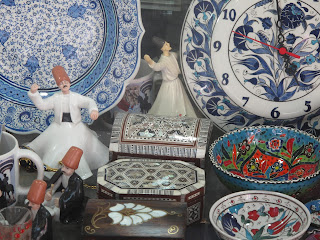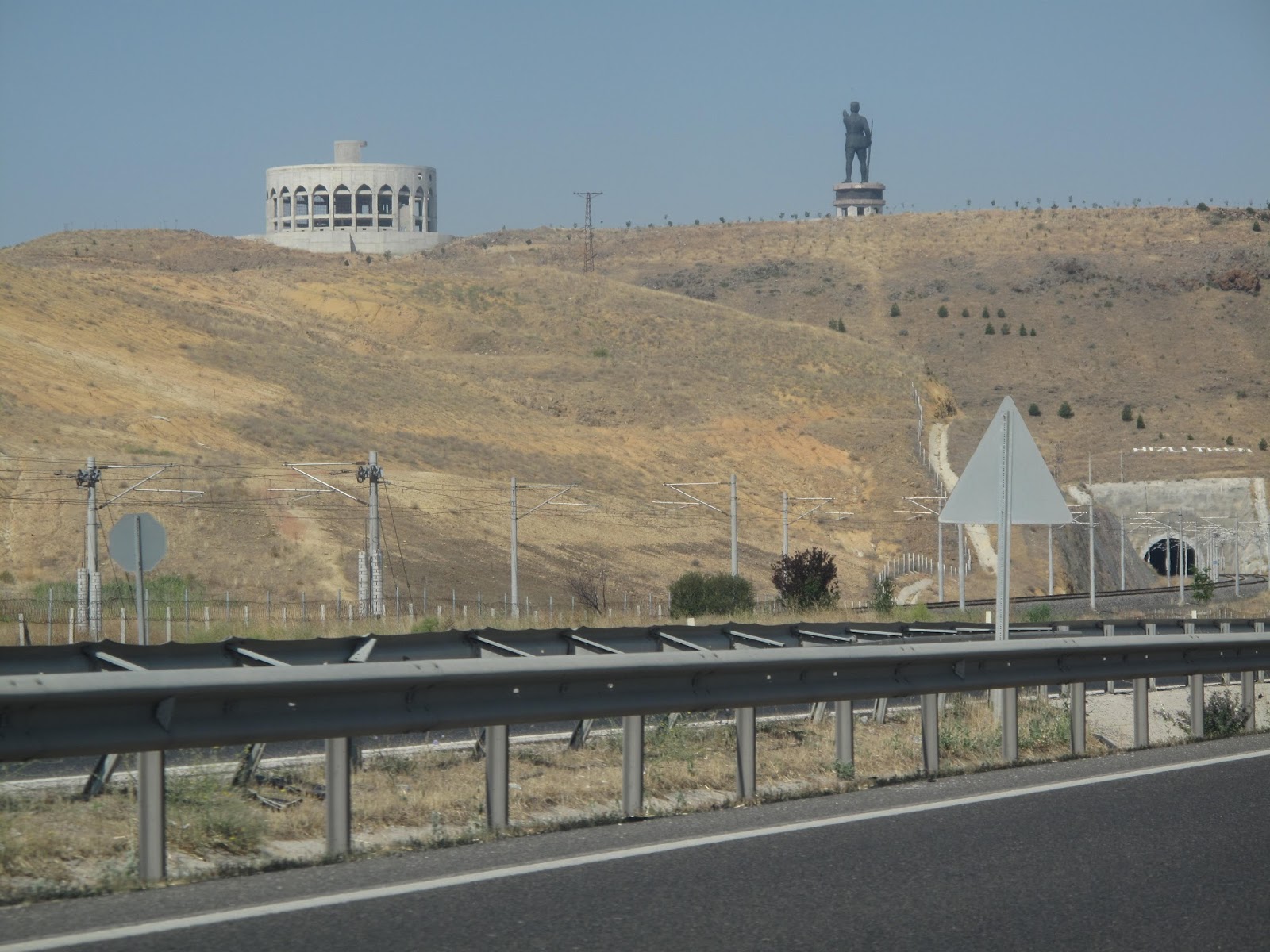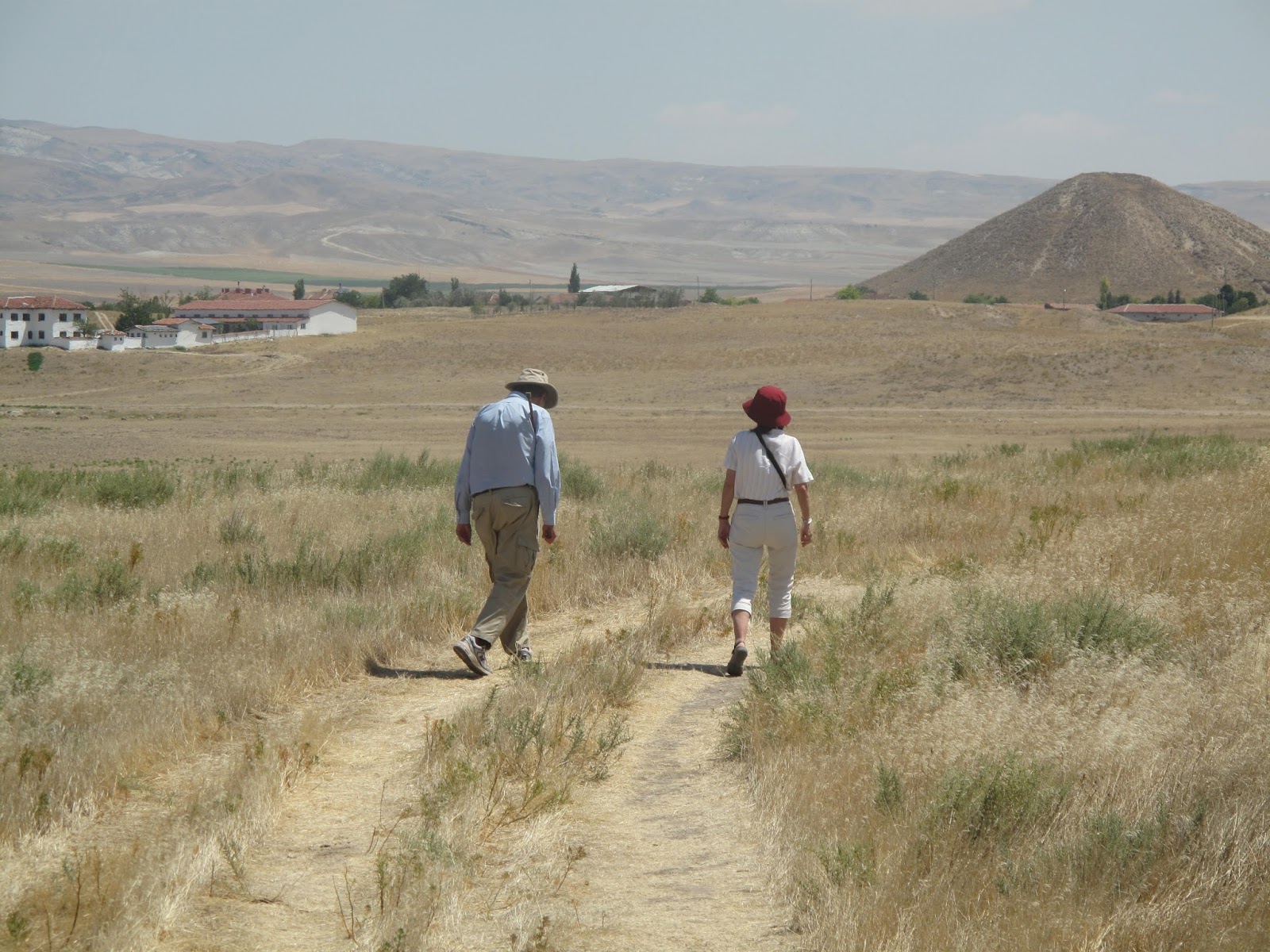Peaches & grapes, the "Reading Woman," and
Tunalı Hilmi Street: an August day in Ankara
When I cut open a peach the other evening, I wasn’t disturbed
when a tiny worm hopped out and began to inch across the plate. August is the prime month for peaches, like
May for strawberries and June-into July for cherries, and because they are so
good, one is bound to eat them regularly.
This was not my first encounter with wildlife in peaches, or in lettuce,
for that matter. I take the worm as a
sign that whatever pesticides are used, they’re not THAT dangerous.
August – and September – are prime months for grapes,
too. On August 15th, important for many
Christians (Orthodox and Catholic, but
not Protestant) as the anniversary of the Assumption of the Virgin Mary (her
death and ascending body & soul to heaven), local Turkish Christians bring
grapes to church for a blessing at the end of the service. Afterwards, they offer the grapes to all who
are present. This is a cheerful mid-summer
harvest ritual and if the service takes place in the middle of a hot day,
eating a handful of grapes is wonderfully cooling.
Swan swims in Swan Park
Duly refreshed, I head for Kızılay, the commercial
district in central Ankara, to arrange for some digital photos to be
printed. Fırat Color, the photo shop I
have been going to for years, has somehow survived the change from traditional
film to digital. Although we are now
devoted to our digital cameras, Marie-Henriette and I agree that holding a
large, glossy photograph gives a satisfaction that looking at a computer screen
cannot match.
Kızılay's "Reading Woman"
On the way to Fırat Color, I stop to greet my favorite
lady in Kızılay. She is not a living
person but a bronze statue of a woman, her hair pulled back in a bun, seated,
bent over as she intently reads a book. Turkey
is not known as a country of readers (other than newspapers), but I hope this
“Reading Woman” (“Okuyan Kadın ”) has
inspired some to take up this pleasure. She
is one of a handful of life-sized statues of men and women in ordinary poses in
this section of town. They were put up
some time ago, but by whom, I don’t know (can any Ankara readers help?).
The "Reading Woman" (center)
The “Reading Woman” sits and reads across from the long-established
Turhan Bookstore at a pedestrian intersection
favored by leftist groups.
Indeed, a table was set up, posters displayed, and flyers were being
handed out.
In addition, a young man, a
hunchback, was holding a sign that read: Kahve
+ Fal 5 TL (= Turkish coffee + Fortune, 5 liras). Fortunetelling from the dregs of a cup of
Turkish coffee is a skill, or talent, or pastime, that is appreciated, but this is the first time I have seen this
commercialized. After placing my order
at Fırat Color, I head in another direction and soon see the following sign: Şok!
Fal + Kahve 7.5 TL (= Shock price!
Fortune + Turkish coffee 7.5 liras).
Clearly, this is becoming an established line of business, and
competitive, too.
After a snack of kaşarlı
simit and ayran (a sesame bread
circle and melted yellow cheese + a slightly salty but very refreshing yogurt
drink), I make my way to my favorite street in Ankara, Tunalı Hilmi
Street. I have been walking on this
street for 40 years and love it for its vitality, its constantly changing mix
of elegant and tacky. I should
specify I like only a certain section of
Tunalı Hilmi, between Bülten Street and Kuğulu Park (Swan Park). North of Bülten, the street has always lacked
character, I’m not sure why.
Chicken döner on Tunalı Hilmi Street
Located here for ages is Flamingo, a pastry shop with
tables for those who wish. I go in rarely,
and anonymously, but Marie-Henriette is greeted rapturously every time she
enters. Other pastry shops, Milka and
Meram, have disappeared, but Mado, with ice cream, opened a few years ago near
the park. Pizza Pino, a pizza restaurant long before chains like Pizza Hut and
Domino’s came in, was a long-lasting stalwart until it moved away. Aslıhan, Marie-Henriette, and I trudged
through the snow to eat there one winter in the later 1970s. Either then or on another occasion I bit down
on ground glass – remnants from a defective jar of anchovies, no doubt – to no
ill effect other than a certain mistrust and caution on all future visits.
Souvenir favorites
Two of my key sources for birthday and Christmas presents
are here: Altın Tuğra, a jewelry store, and the incomparable Çeşni, for traditional
ceramics and other handicrafts, with every year new takes on old themes. The owner, Alper Bey, studied archaeology as
an undergraduate, which must have something to do with the high level of
creativity.
For Rent: yes, the Entire Building
Paşabahçe, a big glass store, another important shopping
stop, is either remodelling or leaving.
Above it used to be TÖMER, the language school established by Ankara
University in 1984, which, incredibly, was the first school where a foreigner
could learn Turkish up to an advanced level in a systematic way. I studied there once, 20 years ago, and found
the course excellent. TÖMER has relocated this branch closer to the city
center.
Tunalı Hilmi Bey, bedecked
Tunalı Hilmi Bey (1871-1928), the man for whom the street
is named, is remembered by a statue at the edge of Kuğulu Park. Hilmi is a traditional man’s name. “Tuna” is Turkish for the “Danube,” the “-lı”
suffix indicating that he, Hilmi, came from that region of the Ottoman Empire –
today’s Bulgaria, in fact. This past
June, he (his statue, at least) must have been startled to witness the impassioned
anti-government demonstrations that took place in this little park. Or, having been something of a protester
himself – a member of the first parliaments of the Turkish Republic, a promoter
of the rights of women, workers, and villagers and the reforming of the Turkish
language – he may well have approved.
Swan Park: Corn on the cob in front of Tunalı Hilmi Bey
When I walked through, the park was its usual tranquil self,
a few swans swimming in the ponds, people sitting on benches or strolling,
enjoying the sunny afternoon.
In front of the Karum shopping center
I continued uphill beyond the park to my last stop,
Karum, a large shopping center in which my eye doctor has his office. Karum is what the ancient Assyrian traders
who settled on the outskirts of central Anatolian cities in the Middle Bronze
Age (19th-17th c. BC) called their district, so it’s nice to have this
connection between modern shopping and antiquity. Karum is extremely well located in a
well-to-do neighborhood, with a Sheraton, a Hilton, and, incongruously, the
Iranian Embassy close by. One of the
first big shopping centers in the city, it eventually faced competition from a
host of newcomers – the proliferation of shopping centers has been a feature of
the AK Party era – and for a while it looked a bit down at the heels. Today, though, it’s definitely livelier: more
shops open, more people wandering around.
Before I take the elevator up to the doctor’s office to be inspected for
new glasses, I go have a cup of tea at the tea stand in one of the side
passages. It’s the last cheap thing I’ll
be having for a while.

















